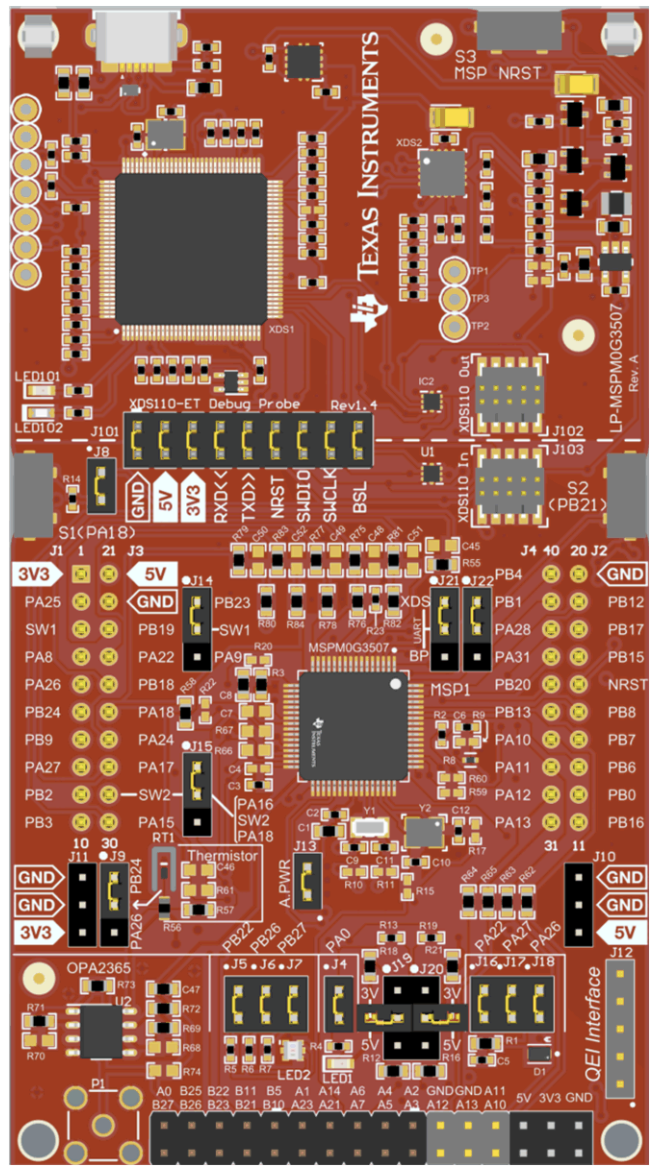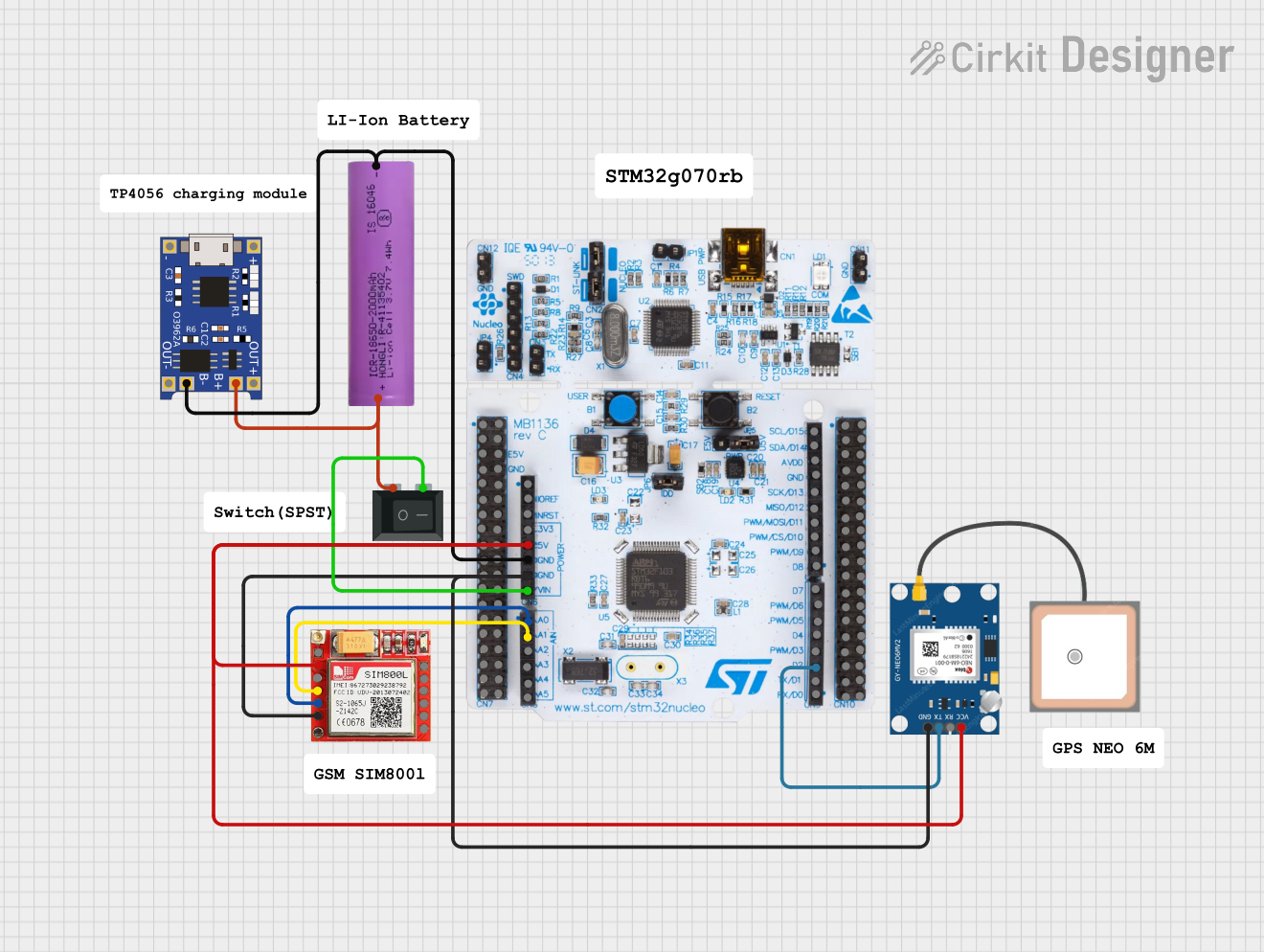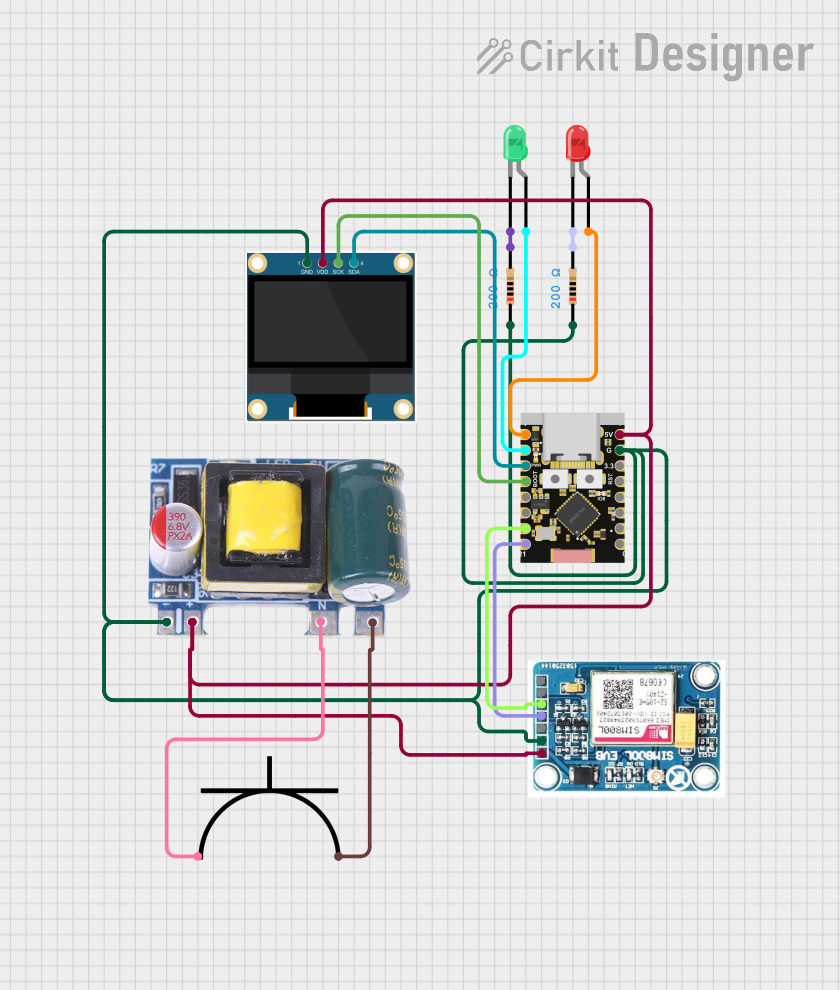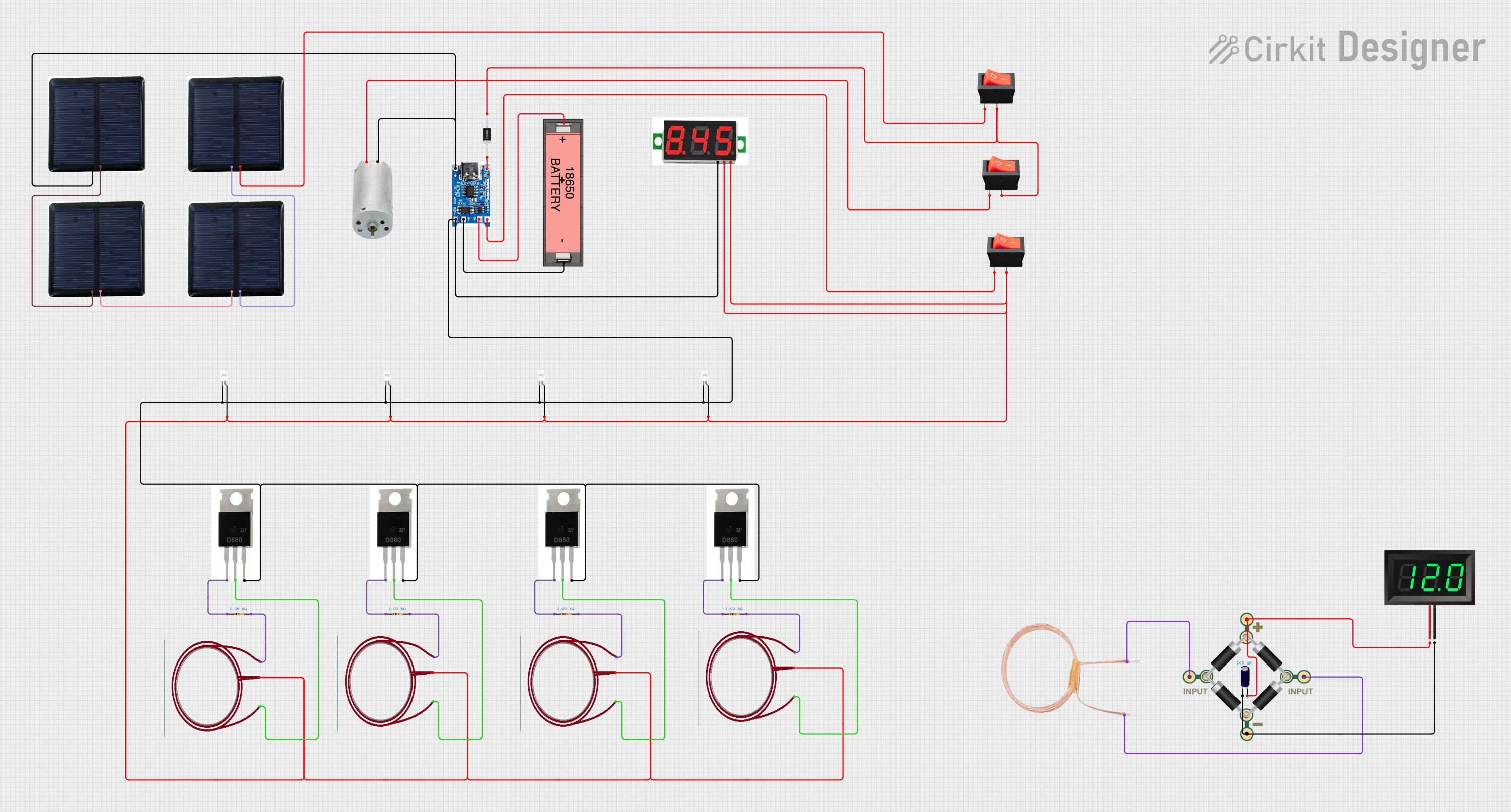
Cirkit Designer
Your all-in-one circuit design IDE
Home /
Component Documentation
How to Use MSPM0G3507: Examples, Pinouts, and Specs

 Design with MSPM0G3507 in Cirkit Designer
Design with MSPM0G3507 in Cirkit DesignerIntroduction
The MSPM0G3507 is a microcontroller from Texas Instruments, featuring an Arm Cortex-M0+ core. It is designed for low-power and cost-sensitive applications, making it ideal for a wide range of embedded systems. The microcontroller includes various peripherals such as Analog-to-Digital Converters (ADCs), timers, and communication interfaces, providing flexibility and functionality for diverse applications.
Explore Projects Built with MSPM0G3507
Battery-Powered Emergency Alert System with NUCLEO-F072RB, SIM800L, and GPS NEO 6M

This circuit is an emergency alert system that uses a NUCLEO-F072RB microcontroller to send SMS alerts and make calls via a SIM800L GSM module, while obtaining location data from a GPS NEO 6M module. The system is powered by a Li-ion battery and includes a TP4056 module for battery charging and protection, with a rocker switch to control power to the microcontroller.
 Open Project in Cirkit Designer
Open Project in Cirkit DesignerArduino Mega 2560 Based Security System with Fingerprint Authentication and SMS Alerts

This circuit features an Arduino Mega 2560 microcontroller interfaced with a SIM800L GSM module, two fingerprint scanners, an I2C LCD display, an IR sensor, and a piezo buzzer. Power management is handled by a PowerBoost 1000 Basic Pad USB, a TP4056 charging module, and a Li-ion 18650 battery, with an option to use a Mini AC-DC 110V-230V to 5V 700mA module for direct power supply. The primary functionality appears to be a security system with GSM communication capabilities, biometric access control, and visual/audible feedback.
 Open Project in Cirkit Designer
Open Project in Cirkit DesignerESP32C3 and SIM800L Powered Smart Energy Monitor with OLED Display and Wi-Fi Connectivity

This circuit is a power monitoring system that uses an ESP32C3 microcontroller to collect power usage data from slave devices via WiFi and SMS. The collected data is displayed on a 0.96" OLED screen, and the system is powered by an AC-DC converter module. Additionally, the circuit includes a SIM800L GSM module for SMS communication and LEDs for status indication.
 Open Project in Cirkit Designer
Open Project in Cirkit DesignerSolar-Powered Battery Charging and Monitoring System with TP4056 and 7-Segment Voltmeter

This circuit is a solar-powered battery charging and monitoring system. It uses a TP4056 module to charge a Li-ion 18650 battery from solar cells and a DC generator, with multiple LEDs and a voltmeter to indicate the charging status and battery voltage. The circuit also includes transistors and resistors to control the LEDs and a bridge rectifier for AC to DC conversion.
 Open Project in Cirkit Designer
Open Project in Cirkit DesignerExplore Projects Built with MSPM0G3507

Battery-Powered Emergency Alert System with NUCLEO-F072RB, SIM800L, and GPS NEO 6M
This circuit is an emergency alert system that uses a NUCLEO-F072RB microcontroller to send SMS alerts and make calls via a SIM800L GSM module, while obtaining location data from a GPS NEO 6M module. The system is powered by a Li-ion battery and includes a TP4056 module for battery charging and protection, with a rocker switch to control power to the microcontroller.
 Open Project in Cirkit Designer
Open Project in Cirkit Designer
Arduino Mega 2560 Based Security System with Fingerprint Authentication and SMS Alerts
This circuit features an Arduino Mega 2560 microcontroller interfaced with a SIM800L GSM module, two fingerprint scanners, an I2C LCD display, an IR sensor, and a piezo buzzer. Power management is handled by a PowerBoost 1000 Basic Pad USB, a TP4056 charging module, and a Li-ion 18650 battery, with an option to use a Mini AC-DC 110V-230V to 5V 700mA module for direct power supply. The primary functionality appears to be a security system with GSM communication capabilities, biometric access control, and visual/audible feedback.
 Open Project in Cirkit Designer
Open Project in Cirkit Designer
ESP32C3 and SIM800L Powered Smart Energy Monitor with OLED Display and Wi-Fi Connectivity
This circuit is a power monitoring system that uses an ESP32C3 microcontroller to collect power usage data from slave devices via WiFi and SMS. The collected data is displayed on a 0.96" OLED screen, and the system is powered by an AC-DC converter module. Additionally, the circuit includes a SIM800L GSM module for SMS communication and LEDs for status indication.
 Open Project in Cirkit Designer
Open Project in Cirkit Designer
Solar-Powered Battery Charging and Monitoring System with TP4056 and 7-Segment Voltmeter
This circuit is a solar-powered battery charging and monitoring system. It uses a TP4056 module to charge a Li-ion 18650 battery from solar cells and a DC generator, with multiple LEDs and a voltmeter to indicate the charging status and battery voltage. The circuit also includes transistors and resistors to control the LEDs and a bridge rectifier for AC to DC conversion.
 Open Project in Cirkit Designer
Open Project in Cirkit DesignerCommon Applications and Use Cases
- Home Automation: Control and monitoring of home appliances.
- Industrial Automation: Process control and monitoring in industrial environments.
- Consumer Electronics: Embedded control in gadgets and devices.
- Wearable Devices: Low-power operation for extended battery life.
- IoT Devices: Connectivity and control in Internet of Things applications.
Technical Specifications
Key Technical Details
| Parameter | Value |
|---|---|
| Core | Arm Cortex-M0+ |
| Operating Voltage | 1.8V to 3.6V |
| Flash Memory | 64 KB |
| SRAM | 8 KB |
| GPIO Pins | Up to 32 |
| ADC | 12-bit, up to 16 channels |
| Timers | 16-bit and 32-bit timers |
| Communication Interfaces | I2C, SPI, UART |
| Power Consumption | Low-power modes available |
| Package | QFN, TSSOP |
Pin Configuration and Descriptions
| Pin Number | Pin Name | Description |
|---|---|---|
| 1 | VCC | Power Supply |
| 2 | GND | Ground |
| 3 | P0.0 | GPIO/ADC Channel 0 |
| 4 | P0.1 | GPIO/ADC Channel 1 |
| 5 | P0.2 | GPIO/ADC Channel 2 |
| 6 | P0.3 | GPIO/ADC Channel 3 |
| 7 | P0.4 | GPIO/ADC Channel 4 |
| 8 | P0.5 | GPIO/ADC Channel 5 |
| 9 | P0.6 | GPIO/ADC Channel 6 |
| 10 | P0.7 | GPIO/ADC Channel 7 |
| 11 | P1.0 | GPIO/ADC Channel 8 |
| 12 | P1.1 | GPIO/ADC Channel 9 |
| 13 | P1.2 | GPIO/ADC Channel 10 |
| 14 | P1.3 | GPIO/ADC Channel 11 |
| 15 | P1.4 | GPIO/ADC Channel 12 |
| 16 | P1.5 | GPIO/ADC Channel 13 |
| 17 | P1.6 | GPIO/ADC Channel 14 |
| 18 | P1.7 | GPIO/ADC Channel 15 |
| 19 | P2.0 | GPIO/I2C SDA |
| 20 | P2.1 | GPIO/I2C SCL |
| 21 | P2.2 | GPIO/SPI MISO |
| 22 | P2.3 | GPIO/SPI MOSI |
| 23 | P2.4 | GPIO/SPI SCK |
| 24 | P2.5 | GPIO/UART TX |
| 25 | P2.6 | GPIO/UART RX |
| 26 | P2.7 | GPIO |
| 27 | P3.0 | GPIO |
| 28 | P3.1 | GPIO |
| 29 | P3.2 | GPIO |
| 30 | P3.3 | GPIO |
| 31 | P3.4 | GPIO |
| 32 | P3.5 | GPIO |
Usage Instructions
How to Use the Component in a Circuit
- Power Supply: Connect the VCC pin to a 1.8V to 3.6V power supply and the GND pin to ground.
- GPIO Configuration: Configure the GPIO pins as needed for your application. For example, if using the ADC, connect the analog input signals to the appropriate ADC channels.
- Communication Interfaces: Connect the I2C, SPI, or UART pins to the corresponding devices if communication is required.
- Programming: Use an appropriate programmer/debugger to upload your firmware to the microcontroller.
Important Considerations and Best Practices
- Power Supply: Ensure the power supply voltage is within the specified range to avoid damaging the microcontroller.
- Decoupling Capacitors: Place decoupling capacitors close to the VCC pin to filter out noise and ensure stable operation.
- Unused Pins: Configure unused GPIO pins as inputs with internal pull-up or pull-down resistors to prevent floating states.
- Low-Power Modes: Utilize the low-power modes to extend battery life in battery-operated applications.
Example Code for Arduino UNO
// Example code to interface MSPM0G3507 with Arduino UNO
// This example reads an analog value from ADC channel 0 and sends it over UART
#include <SoftwareSerial.h>
SoftwareSerial mySerial(10, 11); // RX, TX
void setup() {
mySerial.begin(9600); // Initialize UART communication
pinMode(A0, INPUT); // Set A0 (ADC channel 0) as input
}
void loop() {
int analogValue = analogRead(A0); // Read analog value from ADC channel 0
mySerial.print("Analog Value: ");
mySerial.println(analogValue); // Send the value over UART
delay(1000); // Wait for 1 second
}
Troubleshooting and FAQs
Common Issues Users Might Face
Microcontroller Not Powering On:
- Solution: Check the power supply voltage and connections. Ensure VCC and GND are properly connected.
Incorrect ADC Readings:
- Solution: Verify the analog input connections. Ensure the input voltage is within the ADC's range.
Communication Interface Not Working:
- Solution: Check the connections and configurations of the I2C, SPI, or UART pins. Ensure the correct baud rate and settings are used.
Microcontroller Not Responding:
- Solution: Ensure the firmware is correctly uploaded. Check for any programming errors or issues in the code.
Solutions and Tips for Troubleshooting
- Check Connections: Ensure all connections are secure and correctly made.
- Verify Power Supply: Ensure the power supply voltage is stable and within the specified range.
- Use Debugging Tools: Utilize debugging tools and software to identify and resolve issues in the firmware.
- Consult Datasheet: Refer to the MSPM0G3507 datasheet for detailed information and specifications.
By following this documentation, users can effectively utilize the MSPM0G3507 microcontroller in their projects, ensuring reliable and efficient operation.